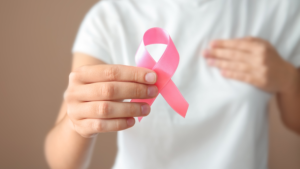Breast Cancer in Women Under 50 on the Rise — Could Cellphones Play a Role?
Recent studies show breast cancer is the most common cancer in women under 50, fueling longstanding concerns about a possible link between devices like cellphones and cancer.

Early-onset breast cancer is on the rise in younger women in the U.S., according to two new peer-reviewed studies, leading some experts to wonder if cellphone use could be at least partially to blame.
The authors of an Aug. 16 study in JAMA Network Open looked at the health data from 2010 to 2019 of more than half a million people in the U.S. under 50 who reported having some kind of early-onset cancer.
They concluded breast cancer in 2019 had the highest incidence rate, with 12,649 new cases reported that year.
Meanwhile, the authors of a study published Sept. 5 in BMJ Oncology looked at worldwide cancer trends from 1990-2019. Breast cancer was responsible for the largest number of cases and associated deaths among younger people, with rates of 13.7 cases and 3.5 deaths per 100,000 people, they said.
Devra Davis, Ph.D., MPH, a toxicologist and epidemiologist who for more than 40 years has studied trends in cancer and who published more than 200 peer-reviewed articles, said she found the reports “very troubling.”
Davis is the president of Environmental Health Trust (EHT), a scientific research and education nonprofit, and founding director of the Board on Environmental Studies and Toxicology of the U.S. National Research Council at the National Academy of Sciences.
She told: “A trend in cancer cannot prove what is causing it. The trend is simply a fact. So the fact is that cancer among younger Americans, particularly women, is on the rise.”
Indeed, the American Cancer Society in 2022 estimated there were 47,550 cases of breast cancer in U.S. women younger than 50.
“But,” Davis added, “there’s clear compelling evidence that electromagnetic fields [EMFs] accelerate the growth of breast cancer cells.”
EMFs can accelerate growth of breast cancer cells
“We have known for nearly 30 years that EMFs can accelerate the growth of MCF-7 breast cancer cells,” Davis said. “There’s no debate about that.”
According to Davis, MCF-7 is an estrogen receptor-positive cancer cell that has been cultured for many years and is used as a standard assay in the laboratory.
Davis said prior research showed radiofrequency (RF) radiation emitted by cellphones moves easily through fat and fluid — “and the breast is nothing but fat and fluid,” she said.
Additionally, a 2020 peer-reviewed study found that excessive smartphone use “significantly increased” the risk of breast cancer, with those using cellphones for more than 4.5 minutes before bedtime having a 5.27-fold increased risk of breast cancer compared to those using a smartphone for less time.
The study authors said:
“To the best of our knowledge, we are the first to find that excessive smartphone use significantly increased the risk of breast cancer, particularly for participants with a smartphone addiction, who maintained a close distance between the breasts and smartphone, and who had the habit of smartphone use before bedtime.”
Staring at a cellphone screen before bedtime can also suppress the natural release of melatonin, a hormone that plays a role in sleep.

Melatonin appears to protect against breast cancer, Davis said. “We know this most especially from studies of blind women because blind women naturally have very high levels of melatonin and they have half the rate of breast cancer of sighted women,” she said.
Some research, however, suggests more thorough studies must be done before the link between melatonin and decreased risk of breast cancer can be proven.
Davis and several co-authors in February 2023 published a review of the latest science on pediatric health, EMFs and RF radiation in which they noted that RF radiation can act like an endocrine disruptor:
“It appears that non-ionizing RFR has all the classic hallmarks of endocrine disruptors that affect reproduction, development of the hypothalamic-pituitary-gonadal axis (HPG) and alter normal male and female reproductive endpoints.”
According to Davis, endocrine disruptors can cause “a host of biological consequences, including breast cancer.”
EHT in 2020 collaborated with the Massachusetts Breast Cancer Coalition to create an educational module for K-12 schools on the health impacts of daily RF radiation exposure and ways to reduce one’s exposure, Davis said.
‘We’re going to see a whole cluster of young people with breast cancer’
According to Davis, there have been at least five case reports of women developing breast cancer tumors where they routinely kept their cellphones in their bras.
One of the case report’s authors, Dr. John West, is a former breast surgeon who more than a decade ago predicted there would be an uptick in breast cancer cases.
West told CBS News in Nov. 2012, “If there is a risk and we don’t find out about it for five or ten years from now, we’re going to see a whole cluster of young people with breast cancer.”
West and his co-authors in 2013 published their case report of four women who carried their smartphones in their bras for up to 10 hours a day for several years, and who “developed tumors in areas of their breasts immediately underlying the phones.”
“These cases,” West and his co-authors said, “raise awareness of the lack of safety data of prolonged direct contact with cellular phones.”
In 2016, West wrote a book about breast cancer prevention, “Prevent, Survive, Thrive: Every Woman’s Guide to Optimal Breast Care,” with a chapter entitled, Your Bra: A No-Phone Zone.
That same year, Dr. Otis W. Brawley, the ACS’ former chief medical officer, highlighted the potential link between cellphone radiation and cancer in a May 27, 2016, press release citing the National Toxicology Program (NTP) multi-year $30 million study showing “clear evidence” that RF radiation is associated with cancer and DNA damage. He said:
“For years, the understanding of the potential risk of radiation from cell phones has been hampered by a lack of good science. This report from the National Toxicology Program (NTP) is good science.”
Brawley said the NTP’s report “marks a paradigm shift in our understanding of radiation and cancer risk.”
But the “paradigm shift” Brawley referenced never took hold after the U.S. Food and Drug Administration (FDA) in 2020 dismissed the NTP study.
According to Davis, the FDA’s rejection of the NTP study was “deeply flawed” and “deeply hypocritical.”
The FDA in 1999 requested the NTP study cellphone radiation, she said. FDA officials were intimately involved in reviewing the study design plans.
“Then when the results came out and some people didn’t like it, the FDA began to trash talk their own study,” Davis said.
To this date, the FDA still claims there is not enough scientific evidence to link cellphone use to health problems, including cancer.
Breast cancer is the most common type of cancer worldwide, excluding non-melanoma skin cancer, with 2.26 million cases in 2020 noted by the World Health Organization.
yogaesoteric
September 28, 2023
Also available in:
 Français
Français
